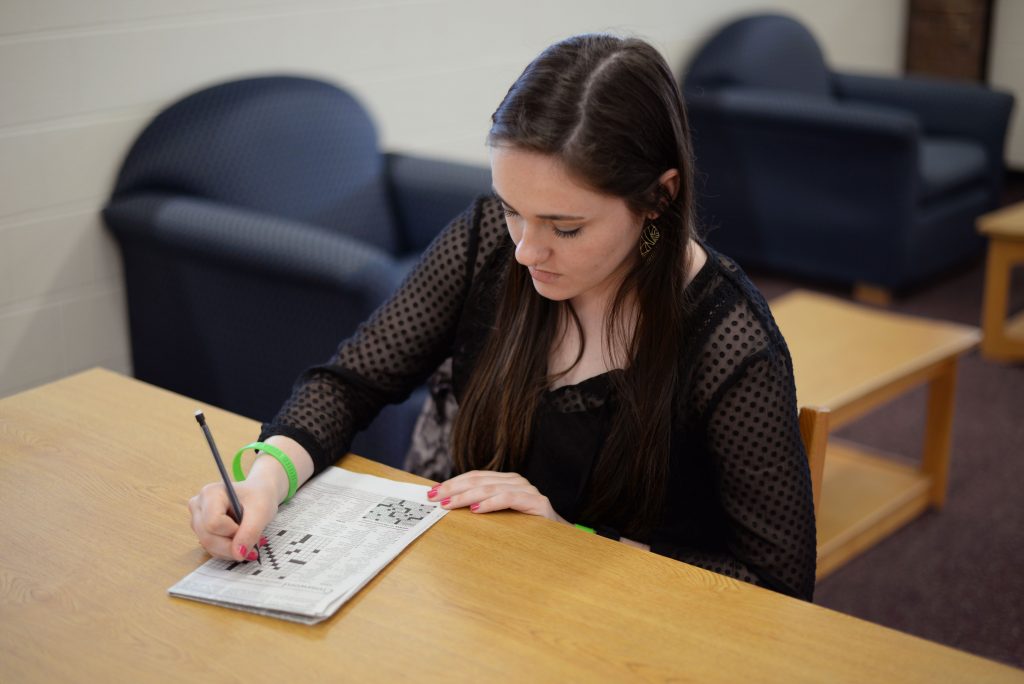
As a true Harpur College student, I’ve taken many classes outside of my major to follow the school’s guiding philosophy: “from breadth, through depth, to perspective.” And while all of these courses have been unique and eye opening, none have impacted me as much as my independent study on crossword puzzles.
Last spring, I started delving into the world of crosswords. My friend Joe Goldin picked up the crossword on his lunch break and brought it back with him after work. I offered to help him by shouting out whatever things came to my mind first. It piqued my interest, and I started helping him more often. Within a week, I was completing the New York Times mini puzzles daily, available for free on their app. I continued the mini puzzles during the summer, but since they took me less than a minute to complete, I constantly found myself craving more. Upon returning to school for my senior year, I decided it was time to try the “real” puzzle on my own.
Learning to do puzzles is very challenging at first. I was fortunate to have Joe to teach me minor things, like what a Rebus is (a puzzle with squares that can hold multiple letters), or that a “?” at the end of a clue means it’s a pun. The more puzzles I did, the better I got. If at the end of the night I hadn’t completed a puzzle, I would turn to an online blog about the New York Times crosswords called Rex Parker Does the NY Times Crossword Puzzle. There, he not only gives you the answers and insight into the theory, but also his own critique of the puzzle. After reading the blog for a few months, I learned that “Rex Parker” is actually Michael Sharp, a professor of English at Binghamton University. Naturally, I fan-girled and sent him an email asking to meet him.
After meeting professor Sharp, Joe and I developed an independent study about crosswords. The first part of the course involved reading up on the history of crosswords, as well as completing the New York Times puzzle each day and coming prepared with comments about the puzzle. I moved from simply completing the puzzle each day (or almost completing it, depending on the day of the week) to considering the puzzle’s structure and clues, analyzing the fills and vocabulary utilized. I began to look at puzzles in a completely different way once I understood how they evolved and what their aims were.
The goal of the class is to produce a publishable puzzle by the end of the semester. Constructing your own crossword is extremely challenging, much more so than I would have ever thought. There is a whole process involved, and the final product reflects a piece of art more so than anything else. The first step is to put in your theme answers. Next, you add the black squares, which to me, is the most challenging aspect. There are unofficial rules in puzzles, like that there can’t be more than 40 black squares, there can’t be two letter words, and the placement of the squares should be the same if you flip the puzzle upside-down. While there are computer programs available to assist constructors, I’m working “old school” (by hand), so adding the black squares in so that the puzzles are symmetrical and so that there aren’t any funky spaces is really difficult.
A highlight of the course was traveling to the American Crossword Puzzle Tournament in Stamford, Connecticut. It was amazing to me that people came from all over the country to show off their puzzling skills, some proudly doing so in crossword printed Toms and scarves. At the tournament, I witnessed people complete a fifteen-minute puzzle in just over two minutes, which was absolutely mind blowing. By far, the most exciting part of the event was meeting Will Shortz, legendary editor of the New York Times Crossword Puzzle.
One of the biggest aspects of this independent study has been learning about the crossword culture. There is a whole community of people devoted to these puzzles, which I never would have known existed. If you think about it, there’s probably a subculture for everything. From comic books to Beanie Babies, there are people who are diehards about any topic. However, the crossword community has its own impressive sense of camaraderie. I’m proud to have explored into the inner workings of the crossword world this semester, and hope to continue improving, one square at a time.
Clare Gilroy is a senior majoring in biology.


